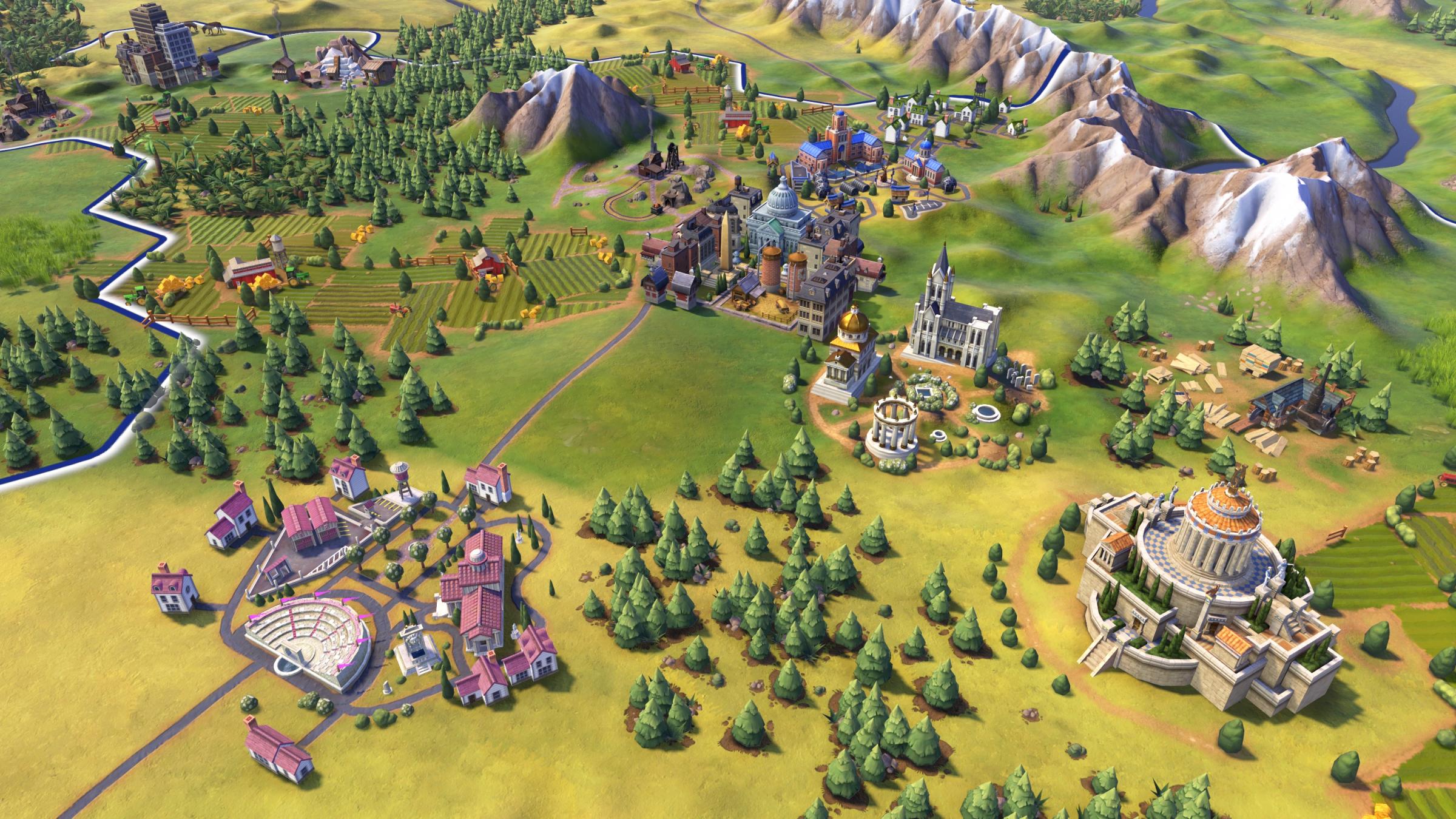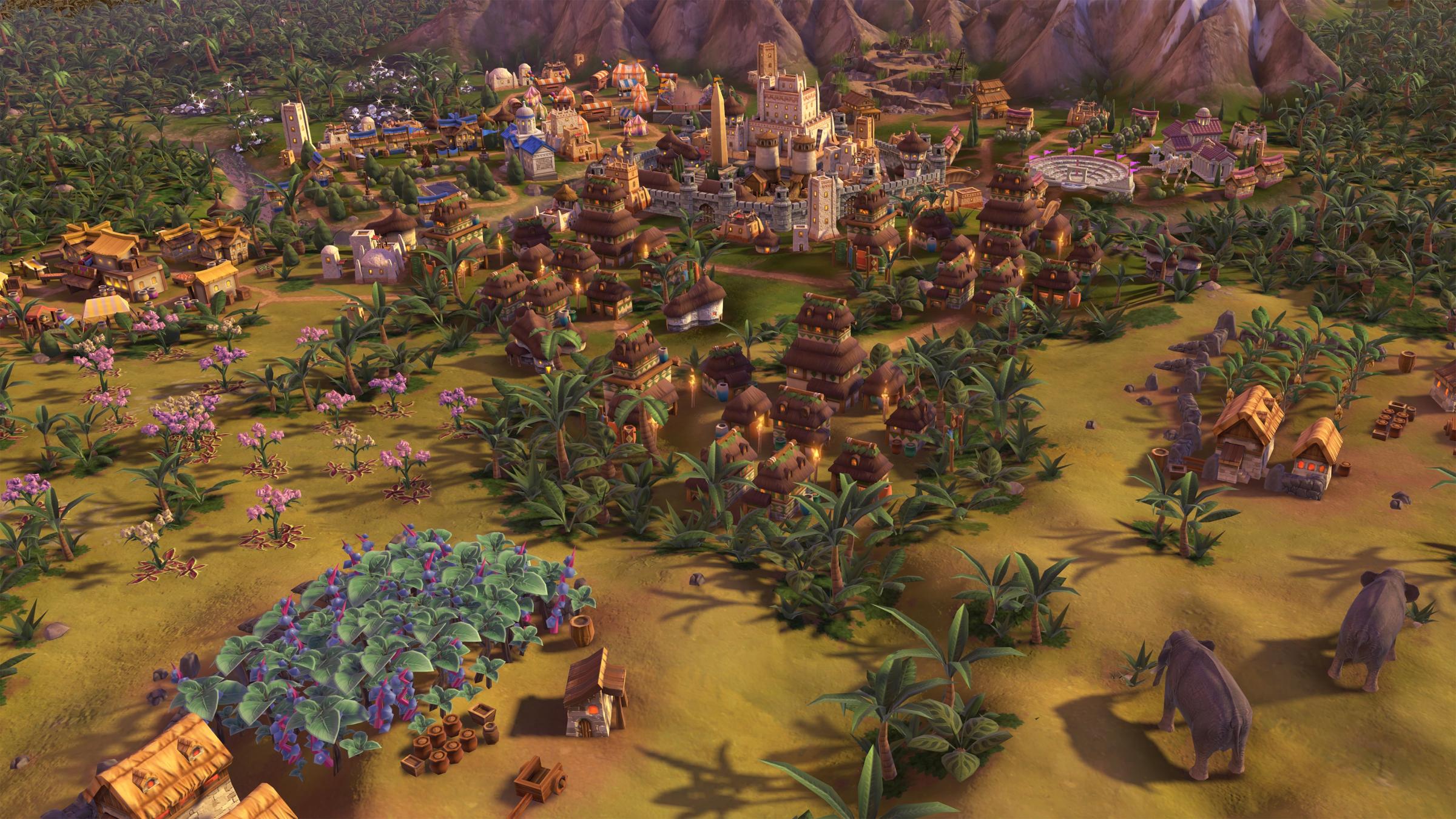I should have known it’d be you, Teddy Roosevelt. Something about the way your handlebar mustache scowled at me during our fraught little chats. I was keeping to myself, peaceably prepping rockets for Mars, and then your armada showed up. After all the gifts I sent! Et tu, Theodore? No matter. When you’re swatting Yankee field cannons and battering rams with rockets and fighter jets, what’s to complain about?
I remember when we obsessed over absurdities like this in the Civilization games. Remember phalanxes taking out tanks? Silly as that sounds, realism’s the wrong hill to die on when you’re playing grand strategy this pulled back, scurrying around lively maps like the finger of a god with mile-high views. What’s important is that the computer knows how to deploy all those weaponized abstractions competently. What matters is that the ghost in the machine knows how to play the game.
My sense after upwards of 1,000 turns with Civilization VI, the newest installment in Firaxis’s turn-based strategy series out for PCs on October 21, is that the computer sometimes does and sometimes doesn’t. It knows, for instance, how to harass you with throngs of units when it’s in a mood. But study what’s happening, and the logistics sometimes look wonky—things you can’t unsee once the bloom fades.

Should faltering enemy units gallop suicidally across the map to attack without pausing a few turns to recover? Does it make any sense that modern units like anti-tank teams joined with obsolete siege towers (by way of a new stacking feature that lets you create “super” units) never decouple? Does declaring war always mean a lesser nation must immediately shotgun troops in your direction, dashed against the sharp, pitiless rocks of definitive military superiority? Why, facing overwhelmingly negative combat odds, wouldn’t a nation pour those resources into throwing opponents off-kilter by dint of asymmetric warfare, from espionage to alternate victory paths in culture, science or religion?
Trouncing Civilization on the higher difficulty settings shouldn’t be this easy. Playing on large maps with 10 civilizations for over 500 turns, paying perfunctory attention to all the new numbers and icons roosting around the interface’s frame, shouldn’t be a glide path to victory. That’s not bragging. I’m no great Civilization player. But there’s something not quite right here. While my assumptions about why the computer’s doing what it’s doing could be wrong, it shouldn’t be this easy to pull off Prince or King difficulty wins. That disappointment doubles when you contrast this with all the stuff Civilization VI gets right.
Like unpacking cities, easily the boldest changeup since 2010’s Civilization V upended the game board by swapping out grids for hexes. Instead of municipalities getting squished into single tiles, a bit like Doctor Who’s TARDIS, they now splay across the map, each city center (one hex) surrounded by fields of districts that take up a hex a piece. Districts by themselves offer a nominal science or culture or faith or capital bonus when built, but they’re really just scaffolding for subsequent builds. Religious Holy Sites let you add a shrine, temple and cathedral in a hex, for instance, while science-oriented Campuses let you add libraries, universities and research labs in another. You can still only tackle one project at a time, so choosing wisely (and ignoring generally wrongheaded advisor picks) is paramount.
On a strictly visual level, it’s nice to see all these series trophies reified. It grounds your sense of progress. But the gameplay ramifications are enormous. Players now have to choose whether to keep a food-shoveling farm or production-positive mine in a hex, say, or supplant it with a Neighborhood (to significantly expand growth potential), a Commercial Hub (a gold production bonanza), or a game-changing Wonder of the world, say the Hanging Gardens (provides bumper city growth) or Oxford University (gives a huge boost to science). That the choices can sometimes be agonizing is a grand thing.

The lay of the land, mountains to forests to “Natural Wonders” (like Wonders, only preexisting and stumbled into), drives further permutations. Thus something like the Alhambra wonder, which adds military policy flex, must be erected on hills adjacent to an Encampment district. Or another like the Colosseum, which boosts culture and happiness, can only go on flatland next to an Entertainment district. All these resource inputs used to sit safely under glass. In Civilization VI, they’ve been divvied up, flung across the map and made vulnerable to pillaging or razing when invaders come knocking. This is the most exposed a Civilization has felt, turning spheres of influence into municipal endoskeletons.
Or take the new envoy system. City states are still cities unto themselves—more than barbarians but less than full opponents. They’ll look after themselves but never really expand. You can attack and overwhelm them, but that’s a waste. What you want to do is woo them with guileful envoys, sharing in their spoils and converting them into proxies. The more you progress along certain paths, the more envoys you can dispatch to city states, the greater the odds you’ll out-woo an opponent and turn city-states into reliable surrogates (they always instantly auto-attack whoever you’re at war with).
Or consider the new deck of cards policy system, which ties military, economic and diplomatic perks to colored cards unlocked by cultural advances. No longer static decisions that illogically hound you indefinitely, policies are now mini-boosts you drag-and-drop into swappable slots. Want more envoys? Pick the “Diplomatic League” or “Containment” cards. Quicker production of air units and naval carriers? Grab “Strategic Air Force.” Culture point boosts linked to special districts? Select “Meritocracy.” You only get periodic shots to reshuffle the deck, so choices matter, but aren’t forever. It’s a wonderfully intuitive way of imbuing governments with the sort of ideological dynamism it feels like the series has been nosing around for forever.

Even quests, which felt tacked on in earlier versions, have finally found their proper place in the tech tree. Complete whatever technology’s optional objective and you’ll rocket ahead, making them critical for science victories. And the happenstance nature of maps keeps quests interesting from game to game. Want to boost Rifling? You’ll need a Niter mine, which assumes you’re near that particular resource (or powerful enough to take it from someone else). Maybe you’d like Sanitation early? You’ll have to build two Neighborhood districts, which assumes your city’s positioned somewhere with sufficient—and sensible, once you run the cost-benefit analysis—real estate.
The point of all this elasticity is pattern preemption—to destabilize players who’d otherwise slip into comfortable ruts. And the surprise is that it works. You have to think on your feet in Civilization VI in ways you’ve never had to before. It reminds me a bit of the secret finale to Jonathan Blow’s The Witness: pattern recognition and prediction only get you so far. The design team told me back in May that it wanted Civilization VI to push players outside their comfort zones. And they’ve done it. Forget Sid Meier’s games as “a series of interesting decisions,” this is design as one surprise after another.
They’ve even solved the series’ endgame tendency to devolve into a boring click-slog, where you’re like an elected official caught in a soporific bill-signing loop. No more. I kept count all the way out to turn 500 in my first game, and though things slow during wartime because of the units suddenly mobilized, across most turns, I had on average five or six scant decisions to make. That Firaxis managed to keep this number so low feels like a legendary design achievement unlock.

My other complaint, and stop me if you’ve heard this one, is that diplomacy feels like shaking the Magic 8-Ball each time a leader rings you up to inveigle, nag or scold. Kudos to Firaxis for making the system a trifle more explanatory, as you’re now told in general terms why someone admires or despises you. But leaders still feel like a bunch of posturing, robotic animations draped over cold, Machiavellian algorithms. Also, repetitive ones: Does Qin Shi Huang really need to tell me, dozens of times and in the same tediously interruptive way, that he despises me for having more Wonders than him?
I love almost everything else about Civilization VI. It’s friendly in a way that belies its complexity. The interface looks busier than it feels, which is to say never convoluted. You can glean all the information you need, without peeping the spreadsheet views hiding under tiny icons (which seem to exist more for the reasons scientists publish their data—so you can double-check the math if you like). It is, in most of the ways that matter, the best-looking, most systemically well thought out, and thereby most fun I’ve had with a Civilization since 1996.
Except for that one thing. So my request, because this is the closest the series has been to solving its central dynamism problems, is to look again at the way the computer’s comporting itself when it’s on the field of battle. I want to believe, but at least in terms of those critical military facets, I need opponents that can make me. Buy here
4 out of 5
Reviewed on PC
More Must-Reads from TIME
- Caitlin Clark Is TIME's 2024 Athlete of the Year
- Where Trump 2.0 Will Differ From 1.0
- Is Intermittent Fasting Good or Bad for You?
- The 100 Must-Read Books of 2024
- Column: If Optimism Feels Ridiculous Now, Try Hope
- The Future of Climate Action Is Trade Policy
- FX’s Say Nothing Is the Must-Watch Political Thriller of 2024
- Merle Bombardieri Is Helping People Make the Baby Decision
Write to Matt Peckham at matt.peckham@time.com